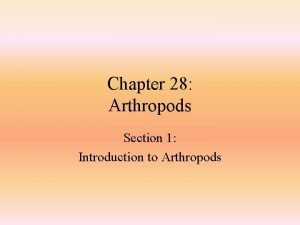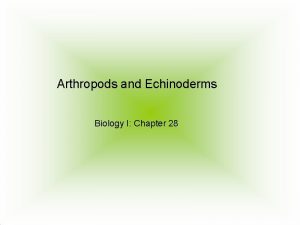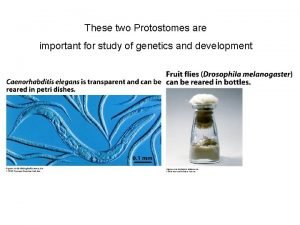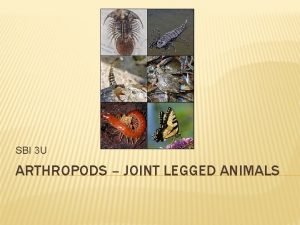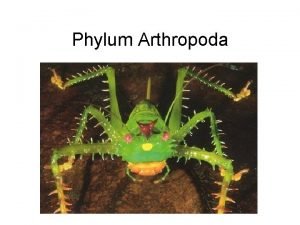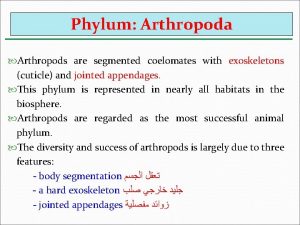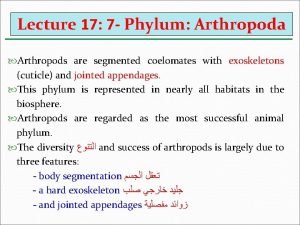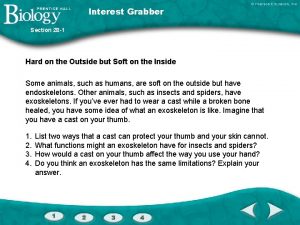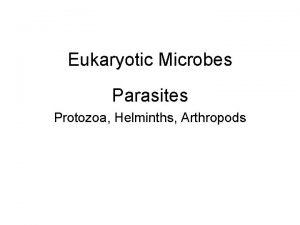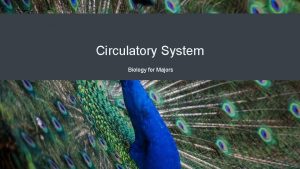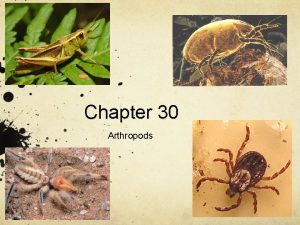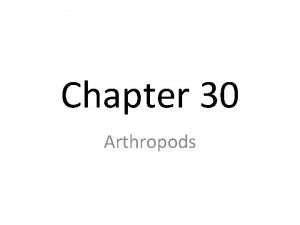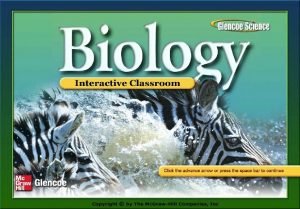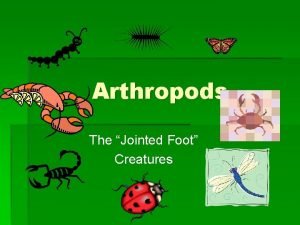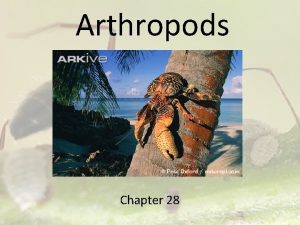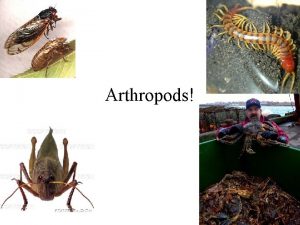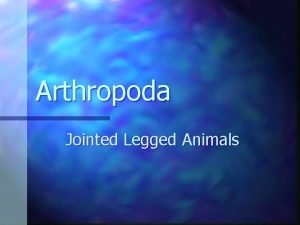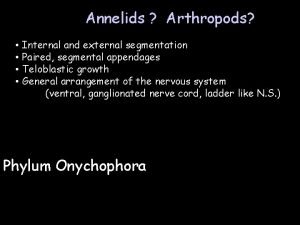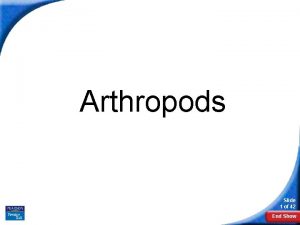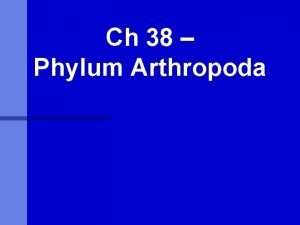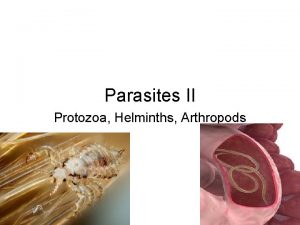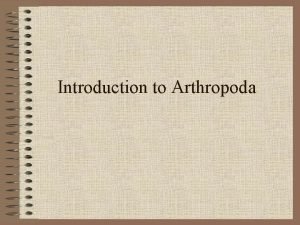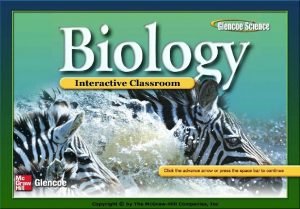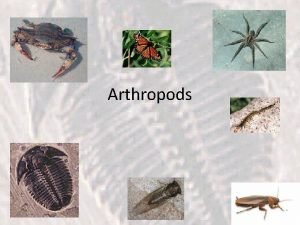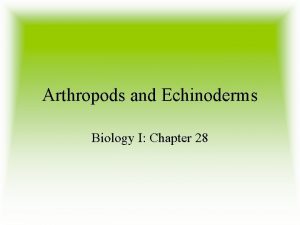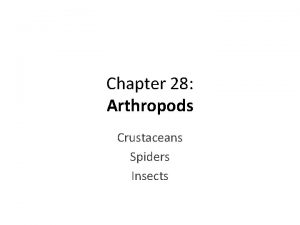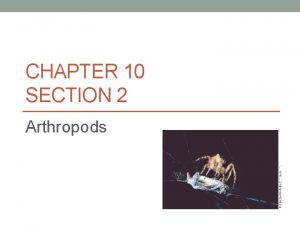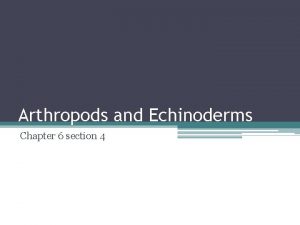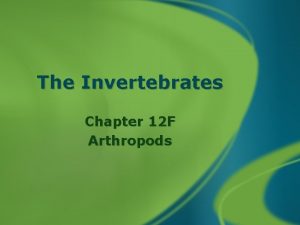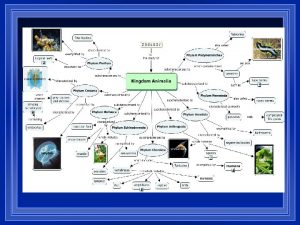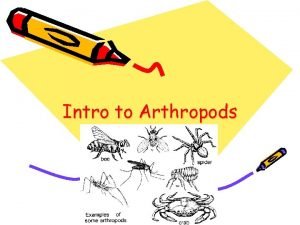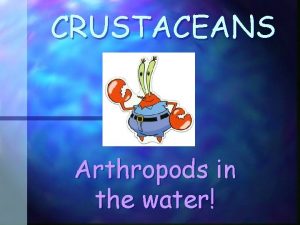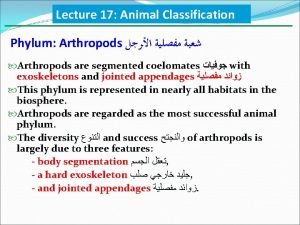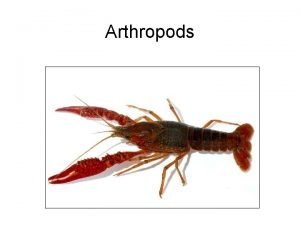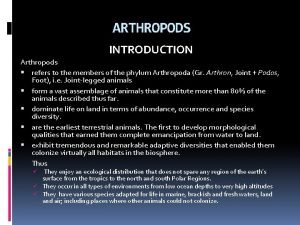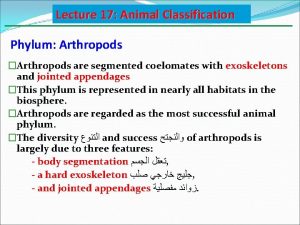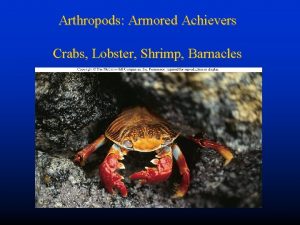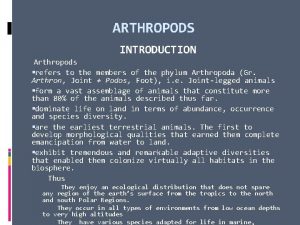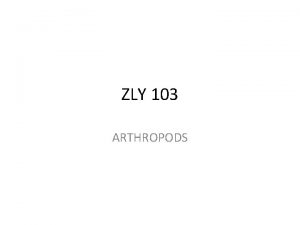Chapter 30 Arthropods I Features of Arthropods A




























- Slides: 28

Chapter 30 Arthropods

I. Features of Arthropods A. Jointed Appendages • Appendages are structures that extend from the arthropod’s body wall • They have joints that bend • Include: - Legs for walking - Antennae for sensing the environment - Mouthparts for chewing food

B. Arthropod Diversity • About 900, 000 species • 2 groups - Arthropods with jaws - Arthropods with fangs or pincers

C. Arthropod Body Plan 1. Segmentation • Individual segments often exist only during the larval stage • Segments fuse into three distinct regions during development a. The head b. The thorax (midbody region) c. Abdomen

2. Compound Eyes • Eyes composed of thousands of individual visual units, each with its own lens and retina • Some arthropods have single-lens eyes that only distinguish light form dark - Function as horizon detects for stabilization during flight

3. Exoskeleton • Composed of chitin • Thin and flexible where the joints are located • Muscles attached to the exoskeleton can pull against it, causing the joints to bend • Provides protection and helps to prevent water loss

4. Molting • An exoskeleton cannot grow larger so the arthropod cannot simply grow bigger • In a process called molting, arthropods shed and discard their exoskeletons periodically

5. Respiration • A network of fine tubes called tracheae • Air enters through spiracles and passes into the tracheae, delivering oxygen throughout the body

6. Excretion • Malpighian tubes extend from the gut and are bathed by blood • Dissolved particles move through the tubules and into the gut • Water, valuable ions, and metabolites are reabsorbed into the body tissues • Metabolic wastes are excreted

II. Spiders and Other Arachnids A. Arachnid Modificaitons • Chelicera are modified into pincers or fangs • Two body parts - Chephalothorax – a head and thorax fused together - Abdomen

B. Arachnid Diversity 1. Spiders • Poison glands secrete a toxin through their fangs • The toxin kills or paralyzes the prey • Enzymes digest the prey’s tissues allowing the spider to suck up liquid fluid

• Only two species of spiders living in the U. S. are dangerous to humans - The black widow and brown recluse • Most spiders can secrete sticky strands of silk from appendages called spinnerets

2. Scorpions • Long, slender, segmented abdomens • Venomous, posterior stinger used to stun their prey • Pedipalps used for seizing food and during sexual reproduction

3. Mites • Chiggers and ticks • Single, unsegmented body • Lyme disease can be spread by infected deer ticks

III. Insects A. Insect Diversity • Chewing mouthparts called mandibles • Three classes - Insecta (insects) - Diplopoda (millipedes) - Chilopoda (centipedes)

B. Insect Body Plan 1. Head • Mandibles and mouthparts are adapted for eating different foods • Compound eyes • Antennae

2. Thorax • Composed of three fused segments • Three pairs of jointed walking legs • Some have one or two pairs of wings 3. Abdomen • 9 to 11 segments

C. Insect Life Cycle 1. Complete Metamorphosis • A wingless, wormlike larva encloses itself within a protective capsule and passes through a pupa stage, in which it changes into an adult • Larvae and adults exploit different habitats and food sources, which decreases competition and increases survival

2. Incomplete Metamorphosis • An egg hatches into a juvenile, or nymph, a small, wingless adult • After several molts, the nymph developed into an adult

D. Flight • Allowed insects to reach previously inaccessible food sources and to escape quickly from danger • Composed entirely of chitin • Have a network of tubes called veins that carry air • In most insects only one pair of wings is functional for flight - Other set serves as protection or stability during flight

E. Social Insects • Highly organized societies of genetically related individuals • Division of labor with different roles, or castes - Determined by heredity, diet, hormones, and pheromones • Workers and soldier are sterile - Reproduction is a function only of the queen and king

F. Insect Relatives 1. Centipedes • One pair of legs per segment • Up to 173 segments • carnivores

2. Millipedes • Two pairs of legs on most segments • 11 to 100 segments • Herbivores

IV. Crustaceans • “Insects of the sea” • Crabs, lobsters, crayfish, shrimps, barnacles, water fleas, and pill bugs • Distinctive larval form called a nauplius with three pairs of branched appendages

A. Terrestrial Crustaceans • Pill bugs and sow bugs • Live in leafy ground litter • Land crabs live in damp areas - Life cycle tied to the ocean, where the larvae live until maturity

B. Aquatic Crustaceans 1. Decapods • Shrimps, lobsters, and crabs • Freshwater crayfish • Five pairs of legs • Cephalothorax covered by a protective carapace

• One anterior pair of legs are modified into large pincers called chelipeds • Swimmerets are attached to the underside of the abdomen • Telson, or tail spine

2. Sessile Crustaceans • Barnacles are sessile as adults • Hard plates that can open and close protect the barnacle’s body • Extend jointed appendages through the open plates to stir food into the barnacles’ mouth • hermaphrodites
 Introduction of arthropods
Introduction of arthropods Arthropods and echinoderms
Arthropods and echinoderms Arthropod groups
Arthropod groups Joint legged
Joint legged Arthropods circulatory system
Arthropods circulatory system Arthropods structure
Arthropods structure Segmented coelomates
Segmented coelomates Arthropods segmentation
Arthropods segmentation Section 28-1 introduction to the arthropods answers
Section 28-1 introduction to the arthropods answers Importance of sanitation
Importance of sanitation Ascaris lumbricoides
Ascaris lumbricoides Arthropods circulatory system
Arthropods circulatory system Joint appendages
Joint appendages Characteristics of arthropods
Characteristics of arthropods Arthropods characteristics
Arthropods characteristics Jointed foot
Jointed foot Arthropods segmented bodies
Arthropods segmented bodies Arthropod characteristics
Arthropod characteristics Arthropod
Arthropod Arthropods are jointed-legged animals. spiders crabs
Arthropods are jointed-legged animals. spiders crabs Annelids vs arthropods
Annelids vs arthropods Section 28-1 introduction to the arthropods
Section 28-1 introduction to the arthropods Arthropoda characteristics
Arthropoda characteristics Section 36-1 review phylum arthropoda
Section 36-1 review phylum arthropoda Proserkoid
Proserkoid Introduction of arthropods
Introduction of arthropods Introduction of arthropods
Introduction of arthropods Chapter 26 section 1 arthropod characteristics
Chapter 26 section 1 arthropod characteristics Pearson prentice hall
Pearson prentice hall
